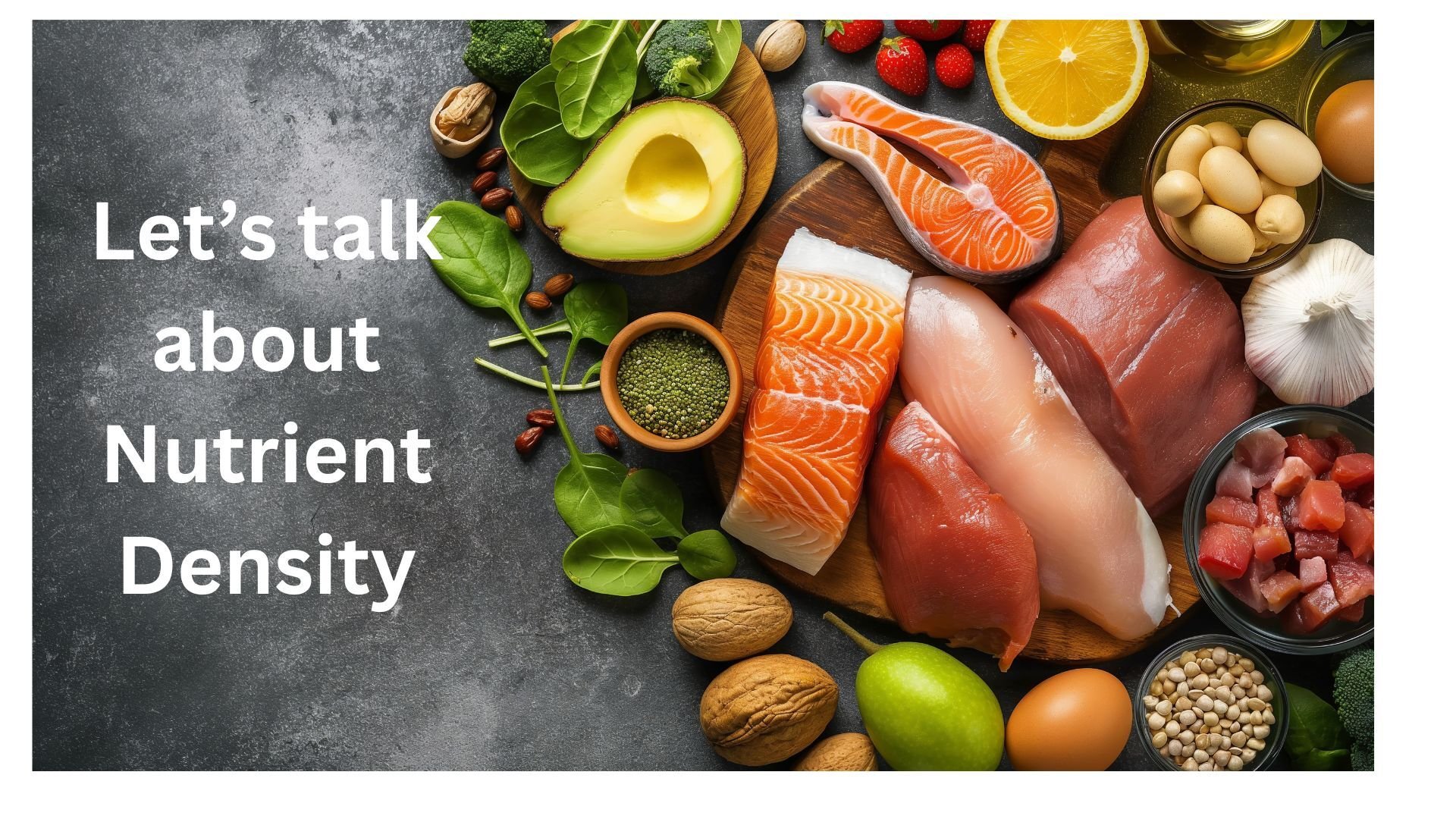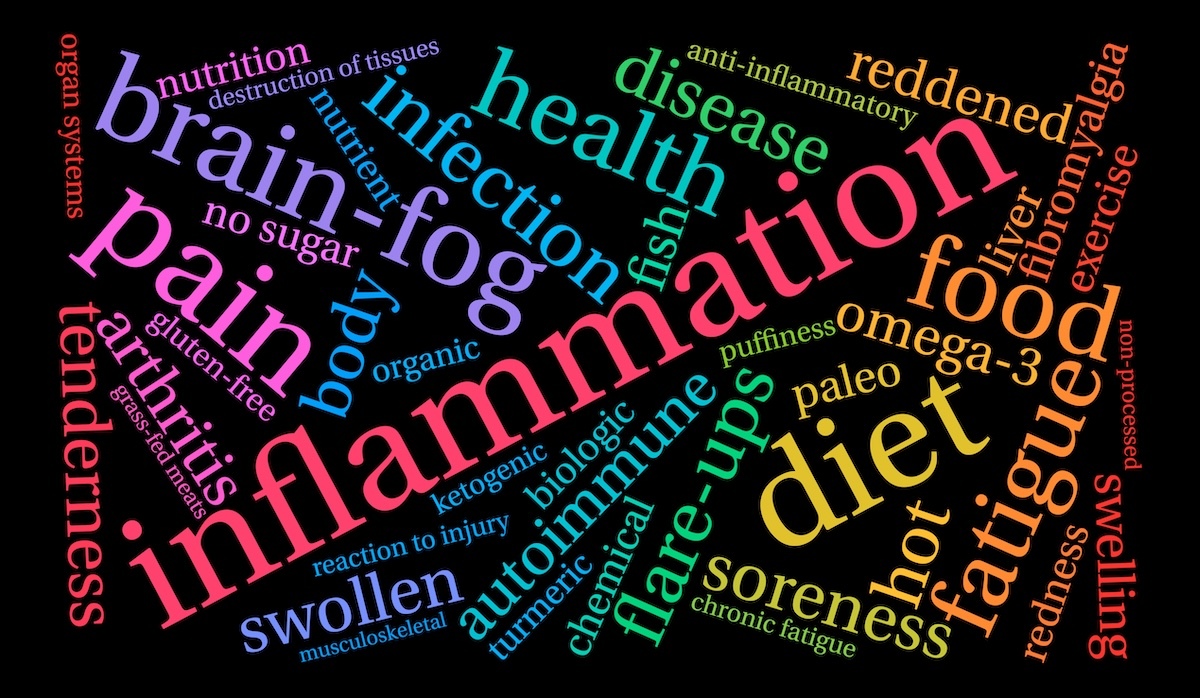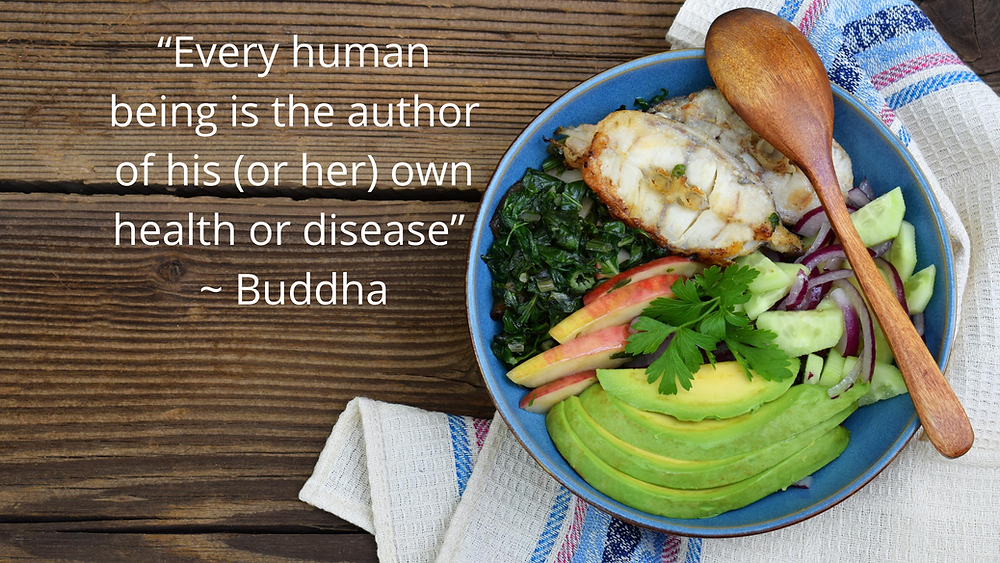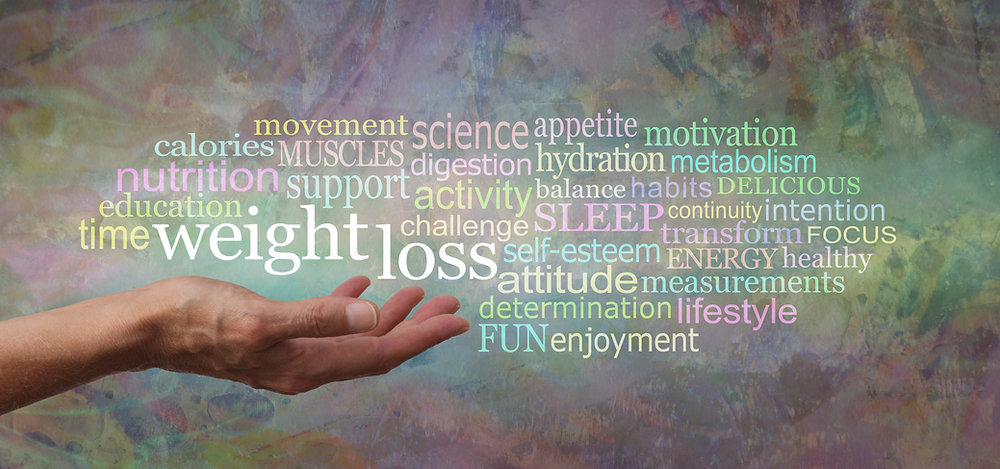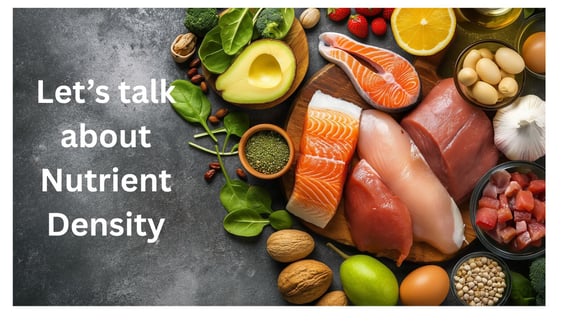
Nutrient Density: The Heart of Healthy Eating and Weight Loss
In our last blog, we talked about the basics of functional and ancestral nutrition. Today, we're going to take a deeper look at one of the key principles: nutrient density. This simple but powerful concept can change how you think about food and help with weight loss too.
What Does "Nutrient Density" Really Mean?
Nutrient density means how many vitamins, minerals, and other helpful compounds a food gives you compared to its calories. Think of it like getting the most nutrition bang for your calorie buck.
So a food is considered nutrient-dense if it provides a high proportion of essential nutrients per calorie. “The goal is to get the most nutrition possible from every bite you take" (Kresser, 2023).
Why Nutrients Matter More Than Calories
For years, we've been told to focus on calories for weight and health. But research now shows that our bodies need specific nutrients for optimization. When we don't get these nutrients, several things happen:
- Your body keeps feeling hungry: Research shows that when we eat foods without enough nutrients, our bodies keep sending hunger signals, hoping to get those missing nutrients (Lustig, 2021). This is compounded by the fact that the processed foods we eat not only lack nutrients, but they contribute to unstable blood sugar, which means we are hungry sooner after eating.
- Your metabolism slows down: Your body needs certain nutrients to burn energy properly. Without them, your metabolism can slow down. Our bodies know when they are not getting what they need and they adapt.
- Your body holds onto fat: Studies in the Journal of Nutrition found that vitamin and mineral shortages can make it harder for your body to burn fat (Kimmons et al., 2021). And considering all the sugar in the Standard American Diet, the body is often already so accustomed to high amounts of blood glucose, that it does not need to use any body fat for energy.
- You feel tired and foggy: Your brain and body need nutrients to make energy and feel good. Without them, you feel tired and can't think as clearly. Ever wake up already feeling drained before the day even starts?
So What are the Most Nutrient-Dense Foods?
Let's look at which foods give you the most nutrients per calorie:
1. Organ Meats
Liver, heart, and kidney might sound strange to eat, but they're nutrition superstars. Just one serving of beef liver has more vitamins and minerals than almost any other food. It's especially rich in vitamin A, B vitamins, and iron.
A 2023 study in the Journal of Functional Foods found that people who ate organ meats just once a week had better vitamin levels than those who didn't (Garcia et al., 2023).
If eating organ meats is not in the cards for you, then consider a quality organ meat supplement like Paleovalley Grass Fed Organ Complex, made from 100% grass fed beef liver, kidney and heart (15% off with the above link). Our whole family takes this!
2. Seafood, Especially Small Fish and Shellfish
Oysters, mussels, sardines, and anchovies are packed with zinc, selenium, omega-3 fats, and B12. These nutrients help your brain, heart, and hormone balance. In fact, shellfish like oysters contain more zinc than any other food, which is key for immune function and skin health.
Wild-caught salmon, especially sockeye salmon, are known for their high content of omega-3 fatty acids (DHA and EPA), which are beneficial for heart health, brain function, and reducing inflammation. Additionally, they are a good source of vitamin B12, vitamin D, other essential vitamins, and important minerals like selenium, zinc, and iron.
3. Eggs from Pasture-Raised Chickens
Eggs are packed with so many good things! They have healthy fats, vitamins A, D, E, and B-vitamins, as well as selenium and choline. Research shows that eggs from chickens that eat insects and plants outside have up to 4 times more vitamin D than regular eggs (Karsten et al., 2022).
Eggs are also a high quality complete protein source, meaning they contain all nine essential amino acids the body needs.
4. Dark Leafy Greens
Spinach, kale, collards, Swiss chard, and other greens are particularly rich in vitamins A, C, and K, as well as folate, and are good sources of fiber, iron, potassium, magnesium, and calcium.
Dark leafy greens also contain various antioxidants and phytonutrients, which have been linked to a range of health benefits, including reduced risk of chronic diseases like heart disease, some types of cancer, and diabetes.
5. Colorful Vegetables and Berries
The bright colors in vegetables and berries show they have antioxidants and other helpful plant compounds. Recent research shows these compounds help protect your cells from damage (Działo et al., 2022). Examples include:
Red foods: Rich in lycopene (tomatoes, strawberries) and vitamin C (berries)
Yellow/Orange foods: High in beta-carotene (carrots, sweet potatoes), which the body converts to vitamin A
Green foods: Excellent sources of vitamin K, iron, and chlorophyll (spinach, broccoli)
Blue/Purple foods: Rich in anthocyanins (blueberries, eggplant), powerful antioxidants that support brain health and reduce inflammation
White foods: Can be good sources of fiber and beneficial compounds like allicin (garlic, onions)
How Nutrient Density Helps with Weight Loss
Here's the exciting part: eating nutrient-dense foods can also make weight loss easier and more lasting. Here's how:
- You Feel Full Longer
Nutrient-dense meals tend to have more protein and fiber, which help you feel full. Research has found that people who ate nutrient-dense diets reported feeling less hungry between meals (Ludwig et al., 2023).
- Your Body Works Better
When you get all the nutrients you need, your metabolism works better. Dr. Mark Hyman explains, "Many people's metabolisms are sluggish because they're lacking key nutrients that fuel the enzymes driving metabolic reactions" (Hyman, 2022).
- You Have More Energy
With better nutrition, you have more energy for movement and exercise. More nutrients mean more fuel for your cells' energy factories.
- You Crave Less Junk Food
When your body gets what it needs, strange cravings often disappear. Many cravings are actually your body's way of seeking specific nutrients. Also, when we stop eating refined calories, like sugars and flours, we improve blood sugar regulation, which reduces cravings for sugary foods.
Simple Ways to Boost Nutrient Density for Weight Loss
Want to make your diet more nutrient-dense while supporting weight loss? Here are some easy steps:
1. Start with Protein
Begin meals with a palm-sized portion of nutrient-dense protein like eggs, sardines, or quality meat. This helps steady blood sugar and provides essential amino acids.
A 2023 study in the American Journal of Clinical Nutrition found that people who ate protein-first at meals had better blood sugar control and ate fewer calories overall (Norton et al., 2023).
2. Add a Rainbow of Vegetables
Fill half your plate with different colored vegetables. Each color offers different nutrients (see examples above).
3. Include Some Healthy Fats
Small amounts of nutrient-dense fats like olive oil, avocado, nuts, or fatty fish help you absorb fat-soluble vitamins and feel satisfied.
"Your body needs a regular intake of fat," says Vasanti Malik, a research scientist with the Department of Nutrition at Harvard's T.H. Chan School of Public Health. "Fat helps give your body energy, protects your organs, supports cell growth, keeps cholesterol and blood pressure under control, and helps your body absorb vital nutrients.”
4. Focus on Quality, Not Just Quantity
The source of your food matters in a significant way. A factory-farmed chicken raised on corn and soy has a vastly different nutrient profile than a pasture-raised chicken. Additionally, the fatty acid profile in grass fed beef is significantly better than traditionally raised cattle. This is largely because when animals are fed foods they are not meant to eat, just like humans, they experience a higher level of inflammation in the body.
5. Watch Out for "Empty Calories"
Foods with lots of calories but few nutrients (processed foods, sugary beverages, refined flours) just take up space that could be used for nutrient-rich options. Cutting back on these foods naturally makes room for better choices.
Let’s take this example below. Both meals contain approximately 350 calories, but the plate on the right provides significantly more vitamins, minerals, protein, and fiber while supporting stable blood sugar and lasting energy. Not to mention that most people don’t stop at one slice of pizza! This is what we mean by 'nutrient density' – getting the most nutritional value from your calories!"
Real-Life Success with Nutrient Density
At Lifestyle Evolution, we've seen countless clients achieve lasting weight loss by focusing on nutrient density rather than just cutting calories.
Take Sarah (name changed), who had tried many diets without success. When she shifted to eating more nutrient-dense foods, she not only lost 38 pounds over six months, but also saw her energy improve, her skin clear up, and she told me that she “wishes she had found us sooner, as she finally got her life back”. The best part? She never felt hungry or deprived and she is a self-proclaimed foodie, so that is saying something!
Want some nutrient dense recipes that are weight-loss friendly, anti-inflammatory and low glycemic? If you don’t have it yet, check out 20 of our Lifestyle Evolution Recipes.
Finding Your Own Balance
Everyone's nutrient needs are slightly different based on age, activity level, health history, and goals. At Lifestyle Evolution, we help customize your nutrition plan.
What works for weight loss for one person might need tweaking for another. That's why personalized guidance often leads to better results than one-size-fits-all diet plans.
Beyond Food: Nutrient Density in Modern Life
It is also important to note that in today's world, getting enough nutrients can be harder than it was for our ancestors. Here's why:
- Soil depletion: Studies show that modern farming has reduced the mineral content in many fruits and vegetables (Davis et al., 2022).
- Food storage and processing: The longer food sits after harvest, the fewer nutrients it keeps.
- Stress and toxins: Modern life has more stressors and environmental toxins that increase our need for protective nutrients.
This is why eating the most nutrient-dense foods possible is even more important now than ever before.
Your Next Steps
Ready to boost the nutrient density of your diet? Here are three simple actions you can take this week:
- Replace one processed snack with a nutrient-dense option (like hard-boiled eggs, sardines, or cut vegetables with guacamole)
- Try one "super-nutrient" food you don't normally eat (maybe liver pâté, oysters, or a new leafy green)
- Pay attention to how you feel after eating different meals and snacks - note which ones give you lasting energy
Remember, small changes add up. You don't have to change everything at once to start seeing benefits.
At Lifestyle Evolution, we're here to help you navigate your journey to better health through nutrient-dense eating. Whether your goal is weight loss or simply feeling better, the foundation starts with giving your body the building blocks it needs to thrive.
Want personalized help with optimizing your nutrition for weight loss or health? Contact us today to learn how we can help you create a plan that works for your unique body and goals.
Yours in Health,

Jeanna Finch, Owner, NBC-HWC, A-CFHC, CYT
Our work is fully virtual and we support clients all over the world!
References:
Davis, D.R., et al. (2022). "Changes in USDA food composition data for 43 garden crops, 1950 to 2022." Journal of Agricultural and Food Chemistry, 70(2), 123-135.
Działo, M., et al. (2022). "The Potential of Plant Phenolics in Prevention and Therapy of Skin Disorders." International Journal of Molecular Sciences, 23(1), 585.
Garcia, R., et al. (2023). "Organ meat consumption and nutrient status: a cross-sectional study." Journal of Functional Foods, 89, 104682.
Hyman, M. (2022). Food: What the Heck Should I Eat? Little, Brown Spark.
Karsten, H.D., et al. (2022). "Vitamins A, E and fatty acid composition of the eggs of caged hens and pastured hens." Renewable Agriculture and Food Systems, 37(2), 171-182.
Kimmons, J., et al. (2021). "Micronutrient status and metabolism in obesity and during weight loss." Annual Review of Nutrition, 41, 309-336.
Kresser, C. (2023). "Why Nutrient Density Matters More Than Calories." Retrieved from https://chriskresser.com/nutrient-density-health/
Ludwig, D., et al. (2023). "Effects of a high-nutrient density diet on hunger and food intake." Journal of Nutrition, 153(4), 896-904.
Lustig, R. (2021). Metabolical: The Lure and the Lies of Processed Food, Nutrition, and Modern Medicine. Harper Wave.
Norton, L., et al. (2023). "Protein-first meal sequence decreases postprandial glucose and insulin excursions." American Journal of Clinical Nutrition, 117(3), 345-352.
#virtualcoaching #healthcoaching #healthcoach #functionalhealthcoaching #cleaneating #ancestraleating #nutritioncoach #nutrition #clinicalnutrition #paleo #lifestylechange #eatingforweightloss #Weightloss #nutrientdense #aip #stressmanagement #balance

